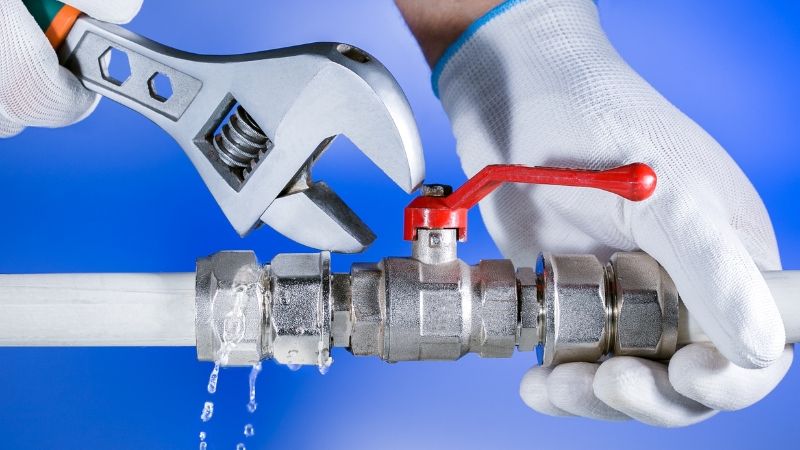Understanding the causes, solutions, and prevention methods for these tiny yet troublesome leaks inside the area is crucial for homeowners. Various factors inside can lead to pinhole leaks in your plumbing system, from corroded pipes to high water pressure issues. Fortunately, there are effective ways to address a pinhole leak before it escalates into a costly repair or extensive water damage. By implementing preventive measures like regular inspections and adjusting water pressure levels, you can safeguard your home from the inconvenience and expenses associated with pinhole leaks.
Table of Contents
ToggleUnderstanding Pinhole Leaks In Copper Pipes
A. Common Occurrence
Pinhole leaks are tiny openings that develop in copper pipes used for water supply. These leaks can happen in both hot and cold water lines, leading to seepage or drips. In older homes with copper plumbing systems, pinhole leaks are a prevalent issue due to the aging of the pipes.
Pinhole leaks often result from various factors such as corrosion, water chemistry, or even improper installation. The combination of these elements can lead to the deterioration of the pipe material over time, causing these small holes, known as pinhole leaks, to form. For instance, if your home’s water has high acidity levels or is too alkaline, it can accelerate corrosion within the pipes.
B. Effects On Plumbing Systems
When left unaddressed, pinhole leaks can cause significant damage to your home’s plumbing system and property. Water seeping from these small openings like pinhole leaks may lead to issues like mold growth, structural damage due to moisture exposure, or even increased water bills from wastage. Identifying pinhole leaks early is crucial in preventing further complications.
To detect pinhole leaks in copper pipes effectively, homeowners can look out for signs such as damp spots on walls or ceilings without any apparent reason; reduced water pressure; discolored water coming out of taps; or unexpected spikes in monthly water bills. Once identified, prompt action should be taken to repair the leak and prevent additional damage.
Causes Of Pinhole Leaks In Copper Piping
A. Corrosion
Corrosion is a significant cause of pinhole leaks in copper pipes. When water interacts with the copper material over time, it can lead to corrosion. This process weakens the pipe walls, creating tiny holes that eventually result in leaks. The chemical reaction between the water and copper causes deterioration, making the pipes vulnerable to developing these small but damaging leaks.
Copper piping systems are commonly used due to their durability and reliability; however, they are not immune to issues like pinhole leaks. Factors such as high levels of acidity or alkalinity in the water supply can accelerate corrosion within the pipes. If left unchecked, this corrosive environment can expedite the formation of pinhole leaks. Homeowners should consider testing their water quality regularly to ensure it falls within acceptable pH levels and prevents accelerated pipe corrosion.
B. Installation Practices
Poor installation practices play a crucial role in causing pinhole leaks in copper piping systems. Improper soldering during installation can weaken connections between pipes or fittings, leading to vulnerabilities that manifest as pinhole leaks over time. Plumbing professionals need to adhere strictly to industry best practices when installing copper piping systems to minimize the risk of future issues like these elusive yet destructive pinhole leaks.
Signs Of Copper Plumbing Pinhole Leaks
A. Indications Of Low Water Pressure
Low water pressure is a common sign that there might be pinhole leaks in copper plumbing. If you notice a decrease in the force at which water flows from your faucets or showerheads, it could be due to these tiny holes in the pipes.
When water pressure drops, it indicates that there may be blockages or leakages within the plumbing system. These pinhole leaks restrict the flow of water, leading to reduced pressure throughout your household fixtures.
B. Discoloration And Staining On Surfaces
Another key indicator of pinhole leaks is discoloration or staining on walls and ceilings. These marks are often caused by water seeping through small openings in the pipes and saturating building materials like drywall.
If you see brownish spots or patches on your walls or ceilings that weren’t there before, it’s crucial to investigate further as they could signal hidden leakage issues within your copper piping system.
C. Unexplained Increases In Water Bills
Undetected pinhole leaks can also manifest as unexplained spikes in your monthly water bills. Since these leaks are typically small, they may go unnoticed for an extended period but can still result in significant wastage and financial implications over time.
If you observe a sudden rise in your water expenses, without any corresponding increase in usage patterns, this could point towards underlying problems such as pinhole leaks compromising the integrity of your plumbing network.
Detecting Pinhole Leaks In Home Plumbing System
- Visual inspection is a crucial method for identifying pinhole leaks. Look for visible signs like water stains, corrosion, or damp spots near the pipes. These can indicate the presence of a leak and help you pinpoint its location accurately. By inspecting your copper pipes regularly, you can catch pinhole leaks early before they escalate into more significant issues.
- Pressure Testing Another effective way to detect hidden pinhole leaks is through pressure testing. This involves pressurizing the plumbing system to identify any pressure drops that could signify a leak. Pressure testing is especially useful when there are no visible signs of leakage but you suspect a problem within your copper pipes.
- Thermal Imaging Cameras Utilizing thermal imaging cameras can also aid in detecting pinhole leaks in copper pipes. These cameras capture temperature differences caused by leaking water, making it easier to identify areas where hot or cold spots are present along the piping system. Thermal imaging technology provides a non-invasive method to locate potential pinhole leaks without causing damage to your property.
Replacing Old Copper Piping
A. Upgrading Materials
If your home experiences frequent pinhole leaks, it might be time to think about replacing the entire copper piping system. By upgrading to alternative materials like PVC or PEX, you can enjoy long-term solutions. These modern materials are less prone to corrosion and pinhole leaks, offering a durable and reliable plumbing system.
Switching from copper pipes to PVC or PEX involves removing the old piping and installing new ones. While copper is known for its durability, it can deteriorate over time due to various factors, leading to pinhole leaks. In contrast, PVC and PEX are more resistant to corrosion, making them ideal choices for homeowners looking for a lasting solution.
B. Professional Installation
When considering replacing your old copper piping with PVC or PEX, hiring a professional plumber is crucial. Proper installation of new piping ensures that your plumbing system functions efficiently without any issues. A skilled plumber has the expertise and experience needed to carry out the replacement correctly, minimizing the risk of future leaks or problems.
A professional plumber will assess your existing plumbing system, remove the old copper pipes carefully, and install the new PVC or PEX pipes accurately. They will ensure that all fittings are secure and that there are no gaps in the piping system where leaks could occur later on.
Preventing Pinhole Leaks In Copper Pipes
A. Regular Testing And Monitoring
Testing and monitoring the pH levels of water is crucial. pH testing kits are inexpensive and easy to use. Low pH levels can indicate acidic water, which accelerates copper pipe corrosion.
Regularly checking the pH level allows early detection of potential issues. If the water’s pH is too low, it’s essential to take action promptly. Monitoring helps catch problems before they escalate into costly repairs or replacements.
B. Installing Water Softeners
Water softeners help reduce corrosion risk in copper pipes by removing minerals like calcium and magnesium that contribute to corrosion.
By installing a water softener, you can prolong the lifespan of your copper pipes significantly. This preventive measure minimizes the chances of pinhole leaks due to corrosion build-up over time.
Softened water also has benefits for appliances like dishwashers and washing machines, as it reduces mineral buildup inside them.
C. Avoiding Harsh Chemicals
Avoid using harsh chemical drain cleaners as they contain substances that can corrode copper pipes over time.
Chemical drain cleaners may provide a quick fix for clogs but cause long-term damage to your plumbing system. Opt for alternative methods like using a plunger or natural solutions instead.
Opting for gentler cleaning solutions ensures the longevity of your copper pipes without compromising their integrity.
Troubleshooting Pinhole Leaks
A. Locating The Leak
- To troubleshoot pinhole leaks, start by examining the affected area and nearby pipes for any signs of water damage. Look out for dampness, discoloration, or mold growth as indicators of a leak. If the leak is not visible, consider using a pipe inspection camera to identify hidden leaks within walls or underground.
- Pinpointing the exact location of pinhole water leaks is crucial in addressing them effectively. By inspecting surrounding areas and pipes carefully, you can determine where the issue originates. This step helps prevent unnecessary disruption to unaffected parts of your plumbing system.
B. Conducting Pressure Tests
- After identifying potential locations, it’s essential to conduct pressure tests on the plumbing system. These tests help evaluate the overall condition of your pipes and pinpoint weak spots prone to leaks like pinholes or pitting. By assessing the system’s integrity through pressure testing, you can proactively address any underlying issues before they escalate.
- Pressure tests involve increasing internal pressure within pipes while monitoring for drops that could indicate a problem area. This method assists in detecting small pinhole leaks that may not be immediately visible but could affect water quality over time.
The Connection Between Water pH and Pipe Deterioration
A. Low pH Levels Accelerating Pipe Deterioration
Water pH levels play a crucial role in the health of your pipes. When water has low pH, it becomes acidic, which can lead to faster deterioration of copper pipes. This acidity causes corrosion that weakens the pipes, making them more prone to developing pinhole leaks.
Acidic water with a low pH acts as an aggressor towards copper pipes, gradually eating away at their inner linings. This corrosive action not only weakens the pipe material but also creates tiny openings over time, resulting in the formation of pinhole leaks. These small holes can cause significant damage if left unaddressed.
B. High pH Levels and Mineral Deposits
On the flip side, high pH levels in water create an alkaline environment that contributes to pipe deterioration through a different mechanism. Alkaline water leads to mineral deposits building up inside the pipes, restricting water flow and exacerbating corrosion issues. While these deposits may seem harmless initially, they can ultimately weaken the pipe structure.
When water with a high pH flows through copper pipes for an extended period, it leaves behind mineral deposits that act as barriers within the pipe system. These obstructions not only impede proper water flow but also provide surfaces where further corrosion can occur. Over time, this combination of restricted flow and increased corrosion weakens the integrity of the pipes.
Final Thoughts
Pinhole leaks in copper pipes can be a real headache, but armed with the knowledge of their causes, signs, detection methods, and prevention strategies, you’re now equipped to tackle them head-on. Remember, early intervention is key when dealing with these pesky leaks. Whether it’s repairing or replacing old copper piping, staying vigilant and proactive can save you from a world of plumbing troubles down the line.
So, keep an eye out for those subtle signs, stay on top of maintenance, and don’t hesitate to seek professional help when needed. By taking these steps, you’ll not only safeguard your plumbing system but also your peace of mind. Prevention truly is better than cure.
Frequently Asked Questions
1. What Are Pinhole Leaks In Copper Pipipes?
Pinhole leaks are tiny, concentrated corrosion spots that develop on the inner surface of copper pipes, leading to small holes. These leaks can cause water damage and should be addressed promptly.
2. Can Pinhole Leaks In Copper Pipes Be Repaired?
Yes, pinhole leaks can be repaired using various methods such as epoxy compounds, pipe clamps, or soldering. The repair method depends on the location and severity of the leak.
3. What Causes Pinhole Leaks In Copper Piping?
Common causes of pinhole leaks include water chemistry imbalance (pH levels), high water pressure, low-quality installation practices, abrasive materials in the water supply, and galvanic corrosion between different metals.
4. How Long Do Copper Pipes Typically Last Before Developing Pinhole Leaks?
The lifespan of copper pipes varies depending on factors like water quality and usage patterns. However, properly installed and maintained copper piping can last anywhere from 20 to 50 years before experiencing issues like pinhole leaks.
Discover the Premier Solution for Pinhole Leaks with Garcia Plumbing and Home Restoration!
At Garcia Plumbing and Home Restoration, we understand the challenges and potential damage caused by pinhole leaks in your home. Our team, renowned for its expertise in pinhole leak detection and repair, is dedicated to identifying those hidden leaks and restoring the integrity of your home’s foundation.
Our commitment at Garcia Plumbing and Home Restoration extends beyond simple repairs; we aim to improve the overall safety and durability of your home. We have earned an outstanding reputation in Contra Costa County for our commitment to excellence, our deep understanding of plumbing complexities, and the trust we’ve built with countless satisfied customers. Don’t let a pinhole leak threaten the stability of your home or lead to costly repairs down the line. Reach out to us today for unparalleled pinhole leak detection and repair services and experience the peace of mind that comes with a secure and sound home foundation!




